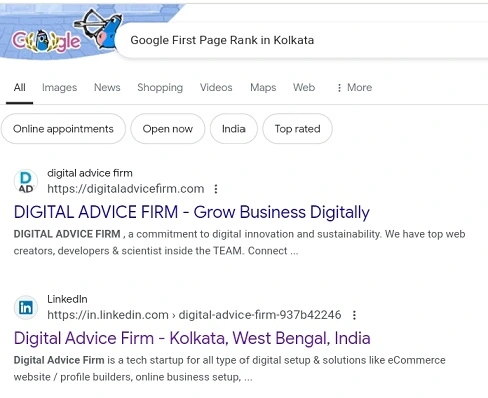Your cart is currently empty!

How to Rank a Website on Google’s First Page?
In today’s digital age, having your website appear on the first page of Google is crucial for driving organic traffic and growing your business. Ranking on the first page of Google involves a mix of on-page SEO, off-page SEO, and technical optimization. In this guide, we’ll walk you through proven strategies and tips on how to rank your website on Google’s first page.

Top 7 Tricks to rank a website on Google’s First Page:
1. Perform Comprehensive Keyword Research:
Keyword research is the main key of any SEO strategy. It helps you understand what terms your potential audience is searching for and how competitive those terms are.
- Use Keyword Research Tools: Tools like Google Keyword Planner, Ahrefs, SEMrush, and Moz can help you identify high-volume keywords with low competition. Aim for a mix of short-tail and long-tail keywords.
- Analyze Competitor Keywords: Look at the keywords your competitors are ranking for. This can provide valuable insights into keyword opportunities you might have missed.
- Focus on User Intent: Understand whether users searching for a keyword are looking for information, making a purchase, or comparing options. Create content that aligns with this intent.
2. Optimize Your On-Page SEO:
On-page SEO involves fine-tuning individual web pages to improve their rankings and attract more relevant visitors.
- Title Tags and Meta Descriptions: Make sure your title tags are compelling and include your primary keywords. Meta descriptions should provide a brief summary of the content and include relevant keywords.
- Header Tags (H1, H2, H3, etc.): Use header tags to structure your content. Your H1 tag should be your main keyword, while H2 and H3 tags should include related keywords and variations.
- Keyword Placement and Density: Naturally incorporate keywords throughout your content. Use primary keywords in the first 100 words and strategically place them throughout the content without keyword stuffing.
- Optimize Images and Media: Use descriptive file names and alt text for images that include relevant keywords. This helps with image search rankings and accessibility.
3. Create High-Quality, Engaging Content:
Content is king when it comes to ranking on Google. High-quality content that provides value to your readers is more likely to rank well.
- Create In-Depth, Valuable Content: Aim for comprehensive guides, how-tos, and long-form content that thoroughly covers the topic. Google tends to favor content that answers user queries in-depth.
- Incorporate Multimedia Elements: Use images, videos, infographics, and interactive elements to make your content more engaging. This can reduce bounce rates and increase time on site, both of which are positive signals to Google.
- Include Internal and External Links: Internal links help distribute page authority across your site, while external links to high-authority sources can improve your content’s credibility.
4. Improve Technical SEO:
Technical SEO focuses on refining the underlying structure of your website to enhance its crawlability and indexing by search engines.
- Optimize Website Speed: Use tools like Google PageSpeed Insights to check your website speed. Compress images, use a Content Delivery Network (CDN), and minimize CSS and JavaScript files to improve load times.
- Ensure Mobile-Friendliness: With Google’s mobile-first indexing, it’s essential to ensure that your website is mobile-friendly. Use responsive design and test your site on various devices.
- Create an XML Sitemap and Robots.txt: An XML sitemap helps search engines understand your website’s structure and find new pages. A robots.txt file tells search engines which pages not to crawl.
- Fix Broken Links and Errors: Regularly audit your website for 404 errors, broken links, and other issues that could affect your SEO.
5. Build High-Quality Backlinks:
Backlinks are one of the most critical ranking factors for Google. Quality backlinks from authoritative sites signal to Google that your content is trustworthy.
- Guest Blogging: Write guest posts for reputable websites in your niche. This not only provides a backlink but also exposes your content to a broader audience.
- Create Link-Worthy Content: Content that is unique, insightful, and valuable is more likely to be linked to by others. Create infographics, original research, and comprehensive guides that others will want to share.
- Engage in Broken Link Building: Find broken links on other websites in your niche and offer your content as a replacement. This is a win-win as it helps them fix broken links and gets you a backlink.
6. Utilize Local SEO if Applicable
For businesses aiming at a local audience, local SEO is crucial. It’s important to remember that SEO is not a one-off task but a continuous effort.
- Optimize Google My Business Profile: Make sure your Google My Business (GMB) profile is complete and optimized with accurate information, including business hours, address, and phone number.
- Collect Positive Reviews: Encourage satisfied customers to leave positive reviews on your GMB profile and other review platforms. Reviews are a strong local ranking factor.
- Local Citations: Ensure your business is listed on local directories with consistent NAP (Name, Address, Phone) information.
7. Monitor and Adjust Your SEO Strategy:
SEO isn’t a one-time effort; it’s an ongoing process that requires continual attention and adjustment. Regularly monitor your website’s performance using tools like Google Analytics, Google Search Console, and Ahrefs.
- Track Key Metrics: Keep an eye on metrics like organic traffic, bounce rate, click-through rate (CTR), and average session duration.
- Conduct Regular SEO Audits: Periodically perform comprehensive SEO audits to identify areas for improvement, from technical SEO to content quality.
- Stay Updated with SEO Trends: SEO is constantly evolving. Stay updated with the latest algorithm updates and trends to adapt your strategy accordingly.
Ranking a website on Google’s first page is challenging but achievable with the right strategies and consistent effort. Focus on creating high-quality content, optimizing your on-page and technical SEO, and building authoritative backlinks. Continuously track your progress and refine your strategies to keep ahead of your competitors. By following these steps, you’ll be well on your way to seeing your website rise in the search engine rankings.
Comments
One response to “How to Rank a Website on Google’s First Page?”
-
Hey! Do you know if they make any plugins to help with SEO?
I’m trying to get my site to rank for some targeted keywords but I’m
not seeing very good gains. If you know of any please share.
Thanks! I saw similar text here
Leave a Reply